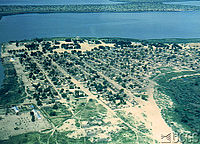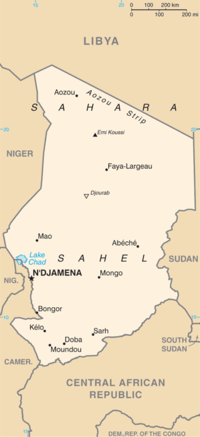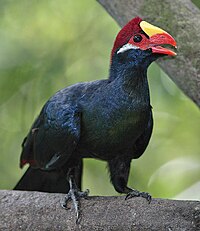
The wildlife of Chad is composed of its flora and fauna. West African lions, buffalo, hippopotamuses, Kordofan giraffes, antelopes, African leopards, cheetahs, hyenas, Bush elephants, and many species of snakes are found there, although most large carnivore populations have been drastically reduced since the early 20th century. Elephant poaching, particularly in the south of the country in areas such as Zakouma National Park, is a severe problem.
Vegetation
 Aerial photo of Lake Chad
Aerial photo of Lake Chad

As of 2011, there were 2,288 species of plants in the country, 55 of which are endemic. Precipitation varies widely from south to the north. The country is also subject to hot, dry, dusty conditions. Harmattan winds are a feature in the northern part of the country. Droughts and locust plagues are also common. The vegetation in the country is broadly categorized under the three regions of the northern Sahara zone, the central Sahel zone, and the southern Sudan zone; all three zones are of equal proportion.
In Chad forest cover is around 3% of the total land area, equivalent to 4,313,000 hectares (ha) of forest in 2020, down from 6,730,000 hectares (ha) in 1990. In 2020, naturally regenerating forest covered 4,293,000 hectares (ha) and planted forest covered 19,800 hectares (ha). For the year 2015, 100% of the forest area was reported to be under public ownership.
The northern part of the country which has the Sahara desert and which borders Libya and the volcanic massif of Tibesti (3,415 metres (11,204 ft)) forms part of the northern zone. Vegetation is dominantly tropical in the tropical zone of the country with deserts having least vegetative growth. However, a large area of desert dunes lie between Lake Chad and the Ouaddai massif, where fringes of xerophytic scrubland is noted.
The montane vegetation on the massif is rich, unlike the vegetation that is in the lowlands. Woody vegetation occurs in some deep gorges of the Ennedi massif, which rises to 1,450 metres (4,760 ft). A flat terrain supports Sahelian grasslands. The transition zone that lies between the southern Sahel and northern Sudan–Guinea is also a seasonal wetland. The Sudan Savanna zone mostly consists of Sudanian woodland with intermittent vegetation of edaphic grassland and Acacia.
The well-drained soils of the area once supported areas of dense woodlands with ebony and kapok trees (species of the Malvaceae family), but this has declined due to soil erosion and degradation. Vegetation found in the area includes acacias, baobab, desert date, palms, African myrrh, and Indian jujube. Found within the lake itself are aquatic plants such as reeds, papyrus, ambatch, and water lilies.
Fauna
Main article: List of mammals of Chad Camels in the Sahel region of Chad
Camels in the Sahel region of Chad Nile perch
Nile perch Violet turaco
Violet turaco
As of 2002, there were at least 134 species of mammals and 532 species of birds (354 species of residents and 155 migrants) in Chad. Before the 20th century, Chad reportedly had a rich fauna of large carnivores in the Lake Chad region, but due to deforestation, hunting and competition from livestock most of the population of lions, leopards, rhinoceros, and hippopotamus have disappeared from the region.
The Zakouma National Park is an important habitat with the highest number of large mammals. Scimitar horned oryx are seen in the reserves of Chad in significant numbers, mostly in the Ouadi Rime Ouadi Achin Faunal Reserve. Also reported to survive in this reserve are the large population of addax (Addax nasomaculatus) and dama gazelle (Nanger dama).
Other species reported are; red-fronted gazelle, dorcas gazelle (Gazella rufifrons, Gazella dama, Gazella dorcas), patas monkey (Erythrocebus patas), striped hyena (Hyaena hyaena), Sudan cheetah (Acinonyx jubatus soemmeringii), caracal (Felis caracal), and Chadian wild dog (Lycaon pictus sharicus), African elephant (Loxodonta africana), otter (Lutra maculicollis), Aonyx capensis, sitatunga (Tragelaphus spekei) and kob (Kobus kob). Rodent species reported are Mastomys verheyeni and gerbil (Taterillus lacustris). African rock pythons and spitting cobras are the reptile species also reported.
Aquafauna
Lake Chad has 179 species of fish which feed on vegetation, phytoplankton and zooplankton. Some of the species reported are catfish (Clarias gariepensis), tilapia, cichlids, characin (Alestes baremoze) and Nile perch (Lates niloticus). Lungfish and sailfin are the two other unique species in the lake. Crocodile and hippopotamus also inhabit the lake as do birds, and it is an important destination for many migratory species of birds.
Avifauna
Main article: List of birds of ChadBirdLife International has reported 532 species of birds of which 354 residents and 155 are migrants, the Avibase - Bird Checklists of the World reports 587 species including 6 globally threatened species. Of these the species under critically endangered, endangered, near-threatened, and vulnerable categories are:
Critically endangered
Endangered
Vulnerable
|
Near-threatened
|
The violet turaco (Musophaga violacea) is a species of least concern, which is found in large numbers in a range of less than 20,000 km (7,700 sq mi) covering many African countries including Chad.
Protection
The protected parks, reserves, protection forests, reforestation areas, and Ramsar Wetlands of international importance in the country include the IUCN Level II categorized Aouk (7,400 km or 2,900 sq mi), Goz Beïda, Manda (1,140 km or 440 sq mi), and Zakouma (3,000 km or 1,200 sq mi) national parks. The country has a number of faunal reserves which are loosely protected including:
- Abou Telfane 1,100 km or 420 sq mi
- Bahr Salamat 20,600 km or 8,000 sq mi
- Beinamar 763 km or 295 sq mi
- Binder-Léré 1,350 km or 520 sq mi
- Fada Archei 2,110 km or 810 sq mi
- Larmanaye 3,040 km or 1,170 sq mi
- Mandelia 138 km or 53 sq mi
- Ouadi Rimé-Ouadi Achim 80,000 km or 31,000 sq mi
- Siniala-Minia 4,260 km or 1,640 sq mi
Aside from the numerous protected forests, Tibesti Massif is also a protected area. The wetlands of international importance—under the Ramsar Convention–are the Ramsar Sites at Lake Fitri (Lac Fitri; 1,950 km or 750 sq mi), Binder-Léré Faunal Reserve (Réserve de faune de Binder-Léré; 1,350 km or 520 sq mi) and the Chadian section of Lake Chad (partie tchadienne du lac Tchad; 16,481.68 km or 6,363.61 sq mi).
In addition to parks and reserves, eight Important Bird Areas (IBAs) have been identified and supported by BirdLife International. These cover 11.2 percent of the country, an area of 146,500 square kilometres (56,600 sq mi), some overlapping with parks and reserves. Of these, the Ouadi Rimé–Ouadi Achim IBA is the largest, covering an area of more than 6 percent of the area of the country.
Conservation
Efforts have been made by the Food and Agriculture Organization to improve relations between farmers, agro-pastoralists and pastoralists in the Zakouma National Park (ZNP), Siniaka-Minia, and Aouk reserve in southeastern Chad to promote sustainable development. As part of the national conservation effort, more than 1.2 million trees have been replanted to check the advancement of the desert, which helps the local economy by way of financial return from acacia trees, which produce gum arabic, and also from fruit trees.
Poaching
Main article: Elephant hunting in ChadPoaching is a serious problem in the country, particularly of elephants for the profitable ivory industry and a threat to lives of rangers even in the national parks such as Zakouma. Elephants have been massacred in herds in and around the parks by organized poaching. The problem is exacerbated by understaffing. A number of wardens have been murdered by poachers.
References
- ^ "Important Bird Areas in Chad" (PDF). BirdLife International. Retrieved 16 October 2013.
- ^ Brundu, Giuseppe; Camarda, Ignazio (2013). "The Flora of Chad: a checklist and brief analysis". PhytoKeys (23): 1–18. doi:10.3897/phytokeys.23.4752. PMC 3690977. PMID 23805051.
- ^ "Plant and Animal Life: Lake Chad". The Living Africa. ThinkQuest. Archived from the original on 17 October 2013. Retrieved 17 October 2013.
- Terms and Definitions FRA 2025 Forest Resources Assessment, Working Paper 194. Food and Agriculture Organization of the United Nations. 2023.
- "Global Forest Resources Assessment 2020, Chad". Food Agriculture Organization of the United Nations.
- Brugière, David; Scholte, Paul (October 2013). "Biodiversity gap analysis of the protected area system in poorly-documented Chad". Journal for Nature Conservation. 21 (5): 286–293. Bibcode:2013JNatC..21..286B. doi:10.1016/j.jnc.2013.02.004.
- World Conservation Monitoring Centre 1991, p. 67.
- ^ "Lake Chad flooded savanna". World Wildflife Organization. Retrieved 16 October 2013.
- ^ "Avibase - Bird Checklists of the World Chad". Avi Base- The world data base organization. Retrieved 16 October 2013.
- BirdLife International (2016). "Musophaga violacea". IUCN Red List of Threatened Species. 2016: e.T22688387A93195573. doi:10.2305/IUCN.UK.2016-3.RLTS.T22688387A93195573.en. Retrieved 13 November 2021.
- "Parks, Reserves, and Other Protected Areas in Chad". Parks.it. Retrieved 17 October 2013.
- "The National Parks and Nature Reserves of Chad". National Parks-Worldwide.info. Retrieved 17 October 2013.
- "Search for protected areas". Official Record. Protectedplanet.net. Retrieved 17 October 2013.
- "Livestock-wildlife-environment interactions in Chad". Food and Agriculture Organization. Retrieved 17 October 2013.
- "African Elephants Slaughtered in Herds Near Chad Wildlife Park". National Geographic. 30 August 2006. Retrieved 17 October 2013.
- Gettleman, Jeffrey (31 December 2012). "Rangers in Isolated Central Africa Uncover Grim Cost of Protecting Wildlife". The New York Times. Retrieved 17 October 2013.
Bibliography
- World Conservation Monitoring Centre (1991). Protected Areas of the World: Afrotropical. IUCN. ISBN 978-2-8317-0092-2.
External links
- USAID detailed study on "Considerations of Wildlife Resources and Land Use in Chad"
| Wildlife of Africa | |
|---|---|
| Sovereign states |
|
| States with limited recognition | |
| Dependencies and other territories |
|